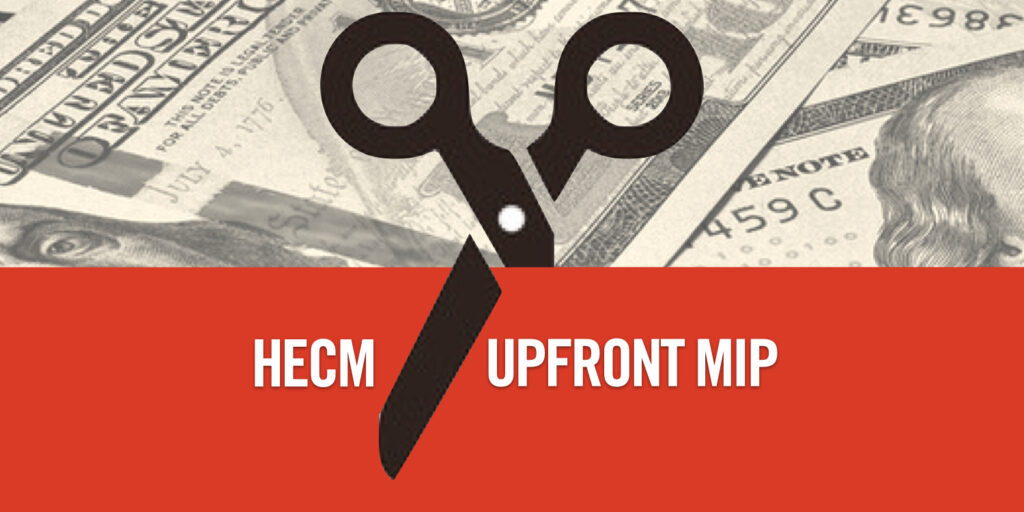An argument why the HECM’s upfront FHA insurance premium should be reduced.
There’s been much discussion recently on the Federal Housing Finance Authority’s recent changes to what’s called Loan-Level-Pricing-Adjustments. But what about the HECM’s upfront fee structure? Before we address that let’s address what loan-level pricing adjustments actually are. After all, in recent weeks social media and news outlets have been buzzing about the Biden administration’s recent changes to loan-level pricing that go into effect today. The Mortgage Reports defines them as “A loan-level pricing adjustment (LLPA) is a risk-based fee assessed to mortgage borrowers using a conventional mortgage. Loan-level pricing adjustments vary by borrower, based on loan traits such as loan-to-value (LTV), credit score, loan purpose, occupancy, and number of units in a home. Borrowers often pay LLPAs in the form of higher mortgage rates.”
Some pundits claim that borrowers with a better credit score are paying a subsidizing borrower with a lower score by paying a slightly higher interest rate. Is that true? Housing Wire contradicts those claims asserting that borrowers with lower FICO scores are not getting better rates than someone with worse credit. However, borrowers with low or moderate incomes will pay no additional fees for loan pricing adjustments, and those who put less than 5% down regardless of their FICO score will benefit Housing Wire reports. Truth be told if one examines specific bands of the new pricing structure an argument could be made either way.
The loan level pricing controversy does bring to mind one of the major challenges to the expanded market acceptance of the HECM: our current fee structure for upfront FHA insurance premiums paid by HECM borrowers regardless of other factors that may mitigate the risk of a claim paid by FHA.
One of the biggest obstacles to consumer acceptance of the federally-insured reverse mortgage is
[read more]
the upfront insurance premium for a home at or above the current HECM limit of $1,089,300 would total a staggering $21,768 premium, Would a reduction of the 2% upfront FHA insurance premium bring more borrowers into the program? And would an influx of new borrowers paying ongoing insurance premiums actually help increase FHA’s loan revenues? To answer this question we reached out to Dan Hultquist of Understanding Reverse. Dan is one of if not our industry’s foremost experts on all things reverse mortgage.
Is a reduction of the initial MIP warranted?

“Absolutely”, says Hultquist. “the IMIP charge is still a stumbling block for almost all reverse mortgage prospects. Anyone that has sold HECMs for any length of time knows that our two primary roadblocks are cost and public perception. Sadly, the former intensifies the problems with the latter”. The two percent upfront premium charge has been part of the HECM handbook for nearly thirty years Hultquist notes, yet it remains in place despite borrowers seeing their loan proceeds reduced by principal limit factor reductions. “By 2009, borrowers could access 62% to 90% of their home value – on day one – depending on their age. Today, borrowers may have principal limits as low as 30%. In addition, borrowers who started the process with a free and clear home, are restricted to 60% of that calculated amount. This means many borrowers may only have access to 18% of their home’s value in the first year. And yet, they still pay the same percentage upfront?”
Wouldn’t reducing the upfront FHA insurance premium hurt FHA’s Mutual Mortgage Insurance Fund? Hultquist contends that a reduction in the HECM’s upfront insurance premium would increase HECM loan volumes, and help more homeowners age in place while bringing removing the price objection that continues to stymie HECM endorsements. That increase in loan volume would ultimately increase the fees FHA collects from HECM borrowers. However, Hultquist notes that the churning or refinance of existing HECMs undermines the performance of the HECM portion of the MMIP, and as such these refinances should pay the full initial mortgage insurance premium as a first-time HECM borrower. This topic warrants an expanded discussion and we hope to have Dan back for a full interview in the coming weeks.
[/read]






10 Comments
Yes. Over the years the IMIP has varied and the 2% amount is truly on the high end. But we should also be pushing HID to adjust PLF table. With the current floor at 3% while rates are in the 6%+ range, is a bigger killer.
The biggest detriment to the program is the upfront insurance fee. I have had several clients walk away from this great program due to the huge upfront costs caused by the UFMIP. Many financial advisors also say the same thing.
Absolutely! The HECM has been, and continues to be, a one-size fits all without regard to a risk-based assessment of the borrower and collateral. Just about EVERYTHING in the financial services sector of our economy has some sort of risk assessment engine behind it. The one-size fits all design should be modified in favor of a more efficient model. Yes, the problem is HECM-to-HECM refinances but there has to be a way to mitigate that risk, and at the same time open up the HECM to a large new marketplace that currently does not consider this option. We simply are not going to move the needle on the miniscule market penetration rate with the current model.
In my opinion there needs to be a better balance between the UFMIP and the PL tables. We are at a point of High Cost to the client along with the lowest borrowing power we’ve ever seen with the program. I fee like small adjustments to both could bring the program to more people and still keep the risk to a reasonable level. FHA/HUD could make small adjustments and greatly expand who could benefit from a HECM
What’s good for the goose is good for the gander. If we are capped at a $6,000 origination fee, they should also be capped at a $6,000 IMIP.
And yes, I agree with Richard that we need to adjust the PLF’S if we want to gain traction.
Hey Shannon
I lost seven or eight loans in the last year because of the 2% MIP.
“What’s the cost of the loan” has always been an issue with the HECM program. Now with FA going into it’s eighth year, FHA needs to take a much closer look at this and possibly introduce “Loan – Level Pricing Adjustments” for our borrowers. Look at it on a tiering system for credit, income, etc. Lowering the LTV tables and the 60% rule is only hurting the senior and industry. People want access to their home equity today not 12 months from now. Would like to see NRMLA have more of a voice with HUD as I feel we are leaving our seniors behind.
The UFMIP is definitely the biggest detriment. As mentioned by others, the fee is a huge hurdle for both the borrowers and their financial advisors.
Is FHA even open to discussing changes?
HUD has two methods for managing risk – 1) Insurance Premiums, and 2) PLFs. Most of us “FEEL” intuitively that the cost (IMIP) is too high relative to the available proceeds (PLFs). This makes the product challenging to sell.
However, to find the optimal premium is an economics problem that requires mathematical analysis.
– What is the appropriate premium for the assumed risk?
– Could HUD increase loan volume and collect more FHA premiums with a premium reduction?
The economist in me would ask “what is the elasticity of demand?” I don’t know the answer, but my gut tells me even a small reduction in premium would boost loan production significantly.
Consider a bell curve:
– If the premiums are extremely LOW (left side X axis), FHA would generate few premiums and expose itself to massive risk.
– If the premiums are extremely HIGH (right side X axis), FHA would still generate few premiums because nobody would buy the product.
So, where is the peak of the bell curve that maximizes premiums and minimizes risk? I’m not the one to do the analytics, but it sure seems 2% is on the far-right side of the bell curve.
I’m not sure if anybody has publicly challenged this and asked for a study. Maybe it’s time.
Absolutely, MIP should be reduced at least to 1%.